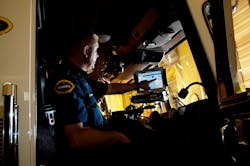Industry Insights: Best Practices for Introducing Technology into Incident Command
Editor's note: Industry Insights are sponsored blogs submitted by manufacturers and suppliers serving the fire service industry.
As an incident commander, you are routinely faced with the highest levels of responsibility, in the most chaotic and volatile situations. Creating a common organizational structure within this environment, with its many distractions, can cause stress levels to rise, which tends to have an effect on critical decision making. Because of the amount of data you are trying to manage, and the nature of the environment you are operating in, many folks are turning to technology to assist them in this data management.
You don’t have to look far to find new technologies becoming available throughout the fire service. There is virtually no product category in the industry that is immune to advances in technology. Whether it be advancements in communications, turnout gear material, software applications, SCBA telemetry, situational awareness tools, or otherwise, technological advancements are becoming increasingly abundant.
Each of these new technologies is built with a purpose. It is your job, as an incident commander, to define whether or not that purpose is relevant to your organization, and aligns with your standard operating procedures.
Accelerating procedures in place
In Jim Collins’ book, “Good to Great,” the author discusses the fact that technology serves as an accelerator as opposed to a creator. This means, that if you have well defined and thought out procedures in place, the implementation of the proper technology can enhance your effectiveness as an incident commander. However, if proper procedures fail to exist, or your existing procedures are ineffective, the implementation of technology will not magically make your command practices more effective.
As an incident commander, it is important to understand the impact of these new technologies, and be able to define what is most relevant to you. The goals of the job remain the same. We still need to protect life, property, and the environment. The advanced data that can be collected through technological advancements can aide you in accomplishing these goals.
For example, implementing a tool such as an electronic accountability system can provide you with real-time visibility of what resources you have on scene, and it can provide you with an additional tool to make sure that everybody returns home safely.
However, this is assuming that your department already has routine accountability practices in place, and habitually performs them. Similarly, and electronic air-management system can provide you with detailed information regarding SCBA air levels among your firefighters. However, these systems do not serve as a replacement for a firefighter’s responsibility of practicing proper air management.
Evaluating new technologies
As an incident commander, once you are comfortable that your department has established procedures on the fire ground. It may, then, be a good opportunity to evaluate if there are new technologies available to make you and your team more effective.
Something to consider, when evaluating new technologies, is whether it is a tool that can be applied throughout the region, as opposed to something that is limited to a single department. The fire service has consistently proven to be effective at sharing resources, as resources tend to be limited, and not everybody has everything.
This same mentality can be used when implementing new technologies. Establishing command at an incident with multiple responding departments becomes easier when those departments are using the same software, communications, etc. Just as NIMS has a focus on establishing a common language when managing an incident, consistent technologies provide better, more clear data, and promote similar SOPs throughout neighboring departments.
The clarity and continuity of data being gathered when common technologies exist, can assist the IC in managing the incident as data-driven decision making becomes less burdensome.
Regardless of the technologies that you use today, or the technologies you intend to use in the future, keep in mind that your process should drive your adoption of technology as opposed to implementing technologies that drive your process.
Adam Fray has been evaluating and implementing technology solutions for the fire service since 2011, and currently serves as the Field Marketing Manager for Software Solutions for Scott Safety. Adam holds a bachelor’s degree from Northern Michigan University and a masters from Davenport University. Adam has supported and led accountability and incident command operations at events throughout the country.







